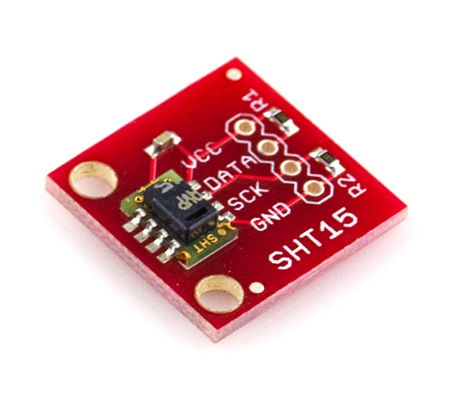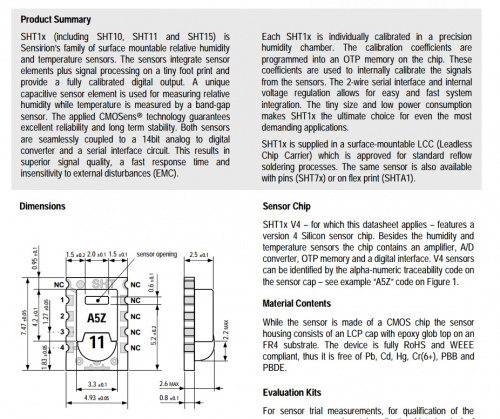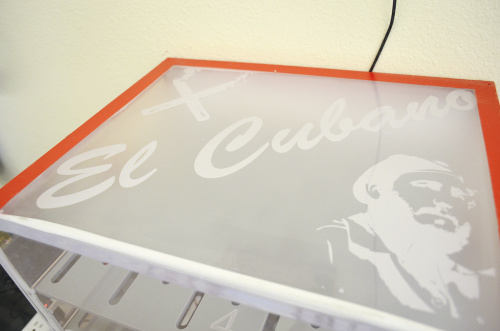Hygrometers, or humidity sensors as they are more commonly called, don't tend to be particularly riveting topics for discussion at most parties, but that doesn't make them any less useful or any less interesting to geeks like us. They are practically everywhere too - medical, HVAC and meteorological equipment are just a few places you'll find them.
For DIYers and SparkFun customers the most common application is the later, though if there's one thing I've learned from working here these last few years it's to never underestimate the ingenuity of the weekend hacker - who knows what use you'll come up with. For that reason, among many others, we want to make sure you're getting what you pay for when you buy something from us. We may not always be able to predict exactly how you're going to use our products but we do understand that, to makers and hackers at least, few things are worse than purchasing something, embedding in a project, and then discovering it doesn't preform the way that it should. On that note I'm sorry to say then that up until late 2011 we were woefully unaware that we had been overlooking a necessary post-assembly procedure with our humidity sensors - re-hydration.
Dead useful, these things.
You see, the two most common types of humidity sensors, at least in our line of work, are capacitive humidity sensors and resistive humidity sensors, both of which tend to use conductive polymers in the way they measure relative humidity. The capacitive type detects the relative humidity of its environment by way of measuring the dielectric constant of that polymer, which is a fancy way of saying it uses the ratio between the capacitance of a capacitor with that polymer between its two planes and the capacitance of a capacitor with a vacuum between its two planes. With the resistive type of humidity sensors, a change in the electrical resistance of that polymer with respect to temperature is used as the primary measurement tool. Either way you slice it, that polymer is essential to the design and functionality, and if it dries out the accuracy of the readings will be negatively affected. How do we know this? Enter the almighty datasheet:
Bow to the datasheet.
It's true that some times these things aren't the most well written pieces of technical jibber-jabber, but it's safe to assume that if the datasheet for the part tells you to care for it a specific way, you should do it. In this case, the datasheet for each of the humidity sensors we carry recommends "re-conditioning" the parts post-population for about 12 hours in an enclosed space at 75% RH. Rehydration becomes especially important when you consider that we put these boards through a reflow oven where the temperature exceeds 260 degrees Celsius. And we live in Colorado, which is on average a very dry state. So then, rehydration is something we should have been doing all along. Why weren't we? Hard to tell, really. I'm not going to make excuses though. What matters is that we weren't doing it. That's our bad and we are terribly sorry for the oversight.
However, I can assure you that we have been re-hydrating each and every humidity sensor we populate for some time now. We now use no-clean solder paste on all of those products as well so that the boards won't be subjected to excessive amounts of moisture either, since that too can damage the component. Once built then, each board spends the aforementioned 12 hours (at least) in a humidity controlled environment. What do we use you ask? Well that's the most interesting part of this story, really. We needed an enclosed space that could both monitor and maintain the relative humidity inside at a stable percentage indefinitely. It also had to be able to store a respectable number of PCBs. I'm sure we could have bought something that does that, but that's not near as fun as building it ourselves though, is it?
We could have bought a standard cigar humidor, but just buying something is boring.
We initially used plastic bins and humidification packs as an immediate, albeit temporary solution. Recognizing we could improve upon the process, we asked our Mechanical Engineer, Paul Smith, to create a more permanent solution. Paul took our detailed specifications for such a device (we told him roughly how many shelves we wanted) and, after a little time in the mechshop, he created El Cubano! It is essentially a humidor for populated PCBs! He was even nice enough to write up a tutorial documenting the build process! You can check that out here.
¡Viva el Cubano!
The moral of the story here (sorry to get all "Full House" on you) is that we weren't aware of this issue until customers spoke up in the comments. We love sharing as much as we can with our customers, and we are always looking for ways to improve the quality of our products. That's why we encourage dialogue and don't just look at Sparkfun as a business but also as a community. You make us better. That's the truth of the matter. So thanks for keeping us on our toes!










So...
You were selling partially hydrogenated sensors? Clogging my arteries! (Sorry I couldn't resist. Really you guys are awesome. I bet many manufacturers wouldn't notice that kind of thing and go to the great lengths you did to fix it)
Sam
Nice tutorial, but: why didn't he use the laser cutter for the control box as well? Okay, it's cool to go berserk and use as many tools as you have available - and teaching how to use Creo and Mach and what not at the same time. But since all the parts are doable on a laser cutter...you know...c'mon. Half the effort and you don't need super expensive software (open source Inkscape will do most of the time).
Nice write-up and thanks for sharing your experience. At work, we manufactured a product for a customer that had the SHT11 and the customer was unaware of the rehydration notes. I actually discovered it while reviewing the datasheet for other reasons. Keep in mind though that Sensirion does not declare it as a requirement and the risk of offset readings can be minimal in some cases. Per the additional comments in the datasheet and from my experience, finished goods that were stored in a typical warehouse in normal packaging for several weeks, would not show any signs of offset readings. The polymer rehydrated from the natural environment which had a typical humidity of 35-45%. Even though the customer did not follow the procedure for close to a year, they never had any issues with the ~3,000 units that were manufactured. (every single unit was validated for accuracy during deployment of the product at an install site)
mmMM Good! IIRC, the OEM also mentions that if you fail to properly recondition the sensor, it will eventually recover on its own, provided the ambient RH% is high enough for long enough period. The SHT series can survive immersion, with similar time-to-recover characteristics. Also, these require NO calibration, EVER...I find that hard to believe, but Sensirion's website has this provenance -and it is ISO 17025 traceable. I have, over time verified performance of these using Rotronic RH% standards and so far it appears to be true.
SF is taking the extra step so the out-of-box experience is ensured. Bravo guys!
Nice! How do you calibrate your hygrometer? And yeah, RTFM. My biggest pet peeve is a manual without pertinent information, especially when you can't find a well-documented equivalent part. Also nice to know the community is paying attention, and that you guys are paying attention to us! That's what a community is all about.
Easy peasy. A saturated solution of many common salts will reach an equilibrium with the surrounding air. Regular NaCl and distilled water is the magic 75%. You need a "slushy" mix with distilled water and pure salt. There should be an excess of the solid salt to ensure that it is a saturated solution.
Magnesium chloride is commonly used for the 33% measurement in a two-point calibration. Somewhat harder to find. Don't use the rough stuff sold for de-icing; not pure enough.
Table at http://www.omega.com/temperature/Z/pdf/z103.pdf
Where did you learn that?
Have a look at the provided table by rawebb: http://www.omega.com/temperature/z/pdf/z103.pdf (PDF) As you can see a saturated NaCl-solution (Sodium Chloride...or what most people say: (common) salt) leads to ~74-76%RH in the whole (sensible) temperature range. Actually, we learn stuff like that in school in Germany.
Don't forget that tomorrow is happy Pi day (3/14).
Live and learn. My last employer (who coincidentally made hygrometers) didn't know that if you don't enable brownout detection on AVR processors the EEPROM can get corrupted. Learned that one the hard way as well.
Yeah, that thin dry air causes problems for baseballs, too.
Should probably point out that if they have condensation on them they won't work (normally output 0%RH)and may also need to go through the baking and re-hydrating process if they don't recover.
When I first started reading this, all I could think about is Fight Club:
"Take the number of vehicles in the field, A, and multiply it by the probable rate of failure, B, then multiply the result by the average out-of-court settlement, C. A times B times C equals X. If X is less than the cost of a recall, we don't do one."
On a serious note, this is quite a cool build you have here. Datasheets are written by people who are hired to engineer, not write.
Well, thank you for the advice!
As of this writing, your product description page does not have any mention of "re-hydration" or a link to this important information for the use of this sensor. Might someone remedy this omission?
As always, RTFM. But yes, it's something most people don't know. As Kinch said below, we will more blatantly display application notes directly from manufacturers so you know what you're getting into. But reading a datasheet and/or application notes is ALWAYS good practice.
And here I thought SF was making Robert wave the little board(s) around when he took his shower, because we all know Robert is super dedicated to his job. Who knew? I know, bad. Tomorrow, I will say three 'our hackers' for my bad.
If you ever come to Seattle, Stop by Data IO. I don't know if they still have it, but they had one that was 10 feet long, 4 feet wide, and 7 feet tall.
I can see that being beneficial should anyone need to re-calibrate their board at any point. We'll try and get something thrown up on each product sometime soon. As of right now that information is available via (if not buried in) the datasheet. We'll be sure to extract it for higher visibility.
Thanks for the suggestion!
Do you still use humidification packs in it, or some other means of controlling humidity?
It actually has a container at the bottom of humidity beads that we periodically refresh with water. The controller box monitors the humidity level and if the RH gets too low it turns on the fans you see in the last picture.